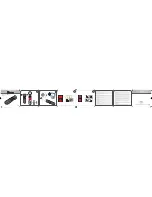
Troubleshooting Tips
46
432-0003-00-10 rev 140 M-Series Operator’s Manual
camera to show the temperature the object itself, rather than of the water
coating.
Eastern or Western Exposure
While under way, the camera may inevitably end up pointing directly east or
west, and this may cause the sun to be in the field of view during certain
portions of the day. We do not recommend intentionally viewing the sun,
but looking at the sun will not permanently damage the sensor. In fact the
thermal imaging camera often provides a considerable advantage over a
conventional camera in this type of back-lit situation. However, the sun may
introduce image artifacts that will eventually correct out. and it may take
some time for the camera to recover. The amount of time needed for
recovery will depend on how long the camera was exposed to the sun. The
longer the exposure, the longer the recovery time needed.
Image freezes momentarily
The camera has a feature that allows the user to momentarily freeze the
image. Double click (press down quickly two times) on the JCU puck to
freeze the image. The snowflake Image Freeze icon will appear on the
screen. Any any other action with the JCU (moving the puck or pushing a
button) will unfreeze the image.
By design, the camera image will freeze momentarily on a periodic basis
during the Flat Field Correction (FFC) cycle. Periodically the image will
momentarily freeze for a fraction of a second while the camera performs a
flat field correction. A shutter activates inside the camera and provides a
target of uniform temperature, allowing the camera to correct for ambient
temperature changes and provide the best possible image. Just prior to
the FFC, a small green square will appear in the upper left corner of the
screen.
Note
:
Pressing and holding the COLOR button will cause the thermal
camera to do an FFC operation.
Multiple Cameras and/or JCUs on a single network
It is possible to have multiple cameras and multiple JCUs on the same net-
work. More than one JCU can be used to control a given camera. The cam-
era will respond to commands from both JCUs in the order the commands
are received across the network. Unpredictable behavior may result from
users sending conflicting commands from separate JCUs (for example, one
user pans left and the other user pans right). In general, the camera will
respond to the last command received and there is no way to set priority,
given that IP networks use a “best effort” delivery protocol.
Summary of Contents for M-Series
Page 1: ...M Series 432 0003 00 10 Revision 140 January 2011 Operator s Manual ...
Page 4: ...432 0003 00 10 rev 140 M Series Operator s Manual 6 Custom Network Applications 61 ...
Page 6: ...8 432 0003 00 10 rev 140 M Series Operator s Manual ...
Page 61: ...432 0003 00 10 rev 140 M Series Operator s Manual 63 ...
Page 62: ...64 432 0003 00 10 rev 140 M Series Operator s Manual ...
Page 63: ...NOTES 432 0003 00 10 rev 140 M Series Operator s Manual 65 ...
















































